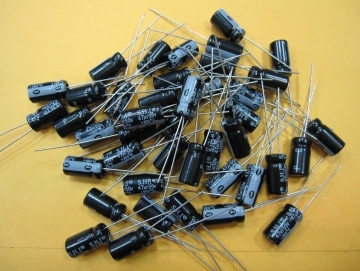News
- 2010-09-08 16:58:49
-

Shin-hang take you into the world of electrolytic capacitors
An electrolytic capacitor is a type of capacitor that uses an electrolyte, an ionic conducting liquid, as one of its plates, to achieve a larger capacitance per unit volume than other types. They are used in relatively high-current and low-frequency electrical circuits, particularly in power supply filters, where they store charge needed to moderate output voltage and current fluctuations in rectifier output. They are also widely used as coupling capacitors in circuits where AC should be conducted but DC should not. There are two types of electrolytic capacitors in common use: aluminum and tantalum.
Electrolytic capacitors are capable of providing the highest capacitance values of any type of capacitor (see Supercapacitors) but they have drawbacks which limit their use. The standard design requires that the applied voltage be polarized; one specified terminal must always have positive potential with respect to the other. Therefore they cannot be used with AC signals without a DC polarizing bias. However there are special non-polarized electrolytic capacitors for AC use which do not require a DC bias. Electrolytic capacitors also have relatively low breakdown voltage, higher leakage current and inductance, poorer tolerances and temperature range, and shorter lifetimes compared to other types of capacitors.
Construction:
Aluminum electrolytic capacitors are constructed from two conducting aluminum foils, one of which is coated with an insulating oxide layer, and a paper spacer soaked in electrolyte. The foil insulated by the oxide layer is the anode while the liquid electrolyte and the second foil acts as the cathode. This stack is then rolled up, fitted with pin connectors and placed in a cylindrical aluminum casing. The two most popular geometries are axial leads coming from the center of each circular face of the cylinder, or two radial leads or lugs on one of the circular faces. Both of these are shown in the picture.
Polarity:
In aluminum electrolytic capacitors, the layer of insulating aluminum oxide on the surface of the aluminum plate acts as the dielectric, and it is the thinness of this layer that allows for a relatively high capacitance in a small volume. This oxide has a dielectric constant of 10, which is several times higher than most common polymer insulators. It can withstand an electric field strength of the order of 25 megavolts per meter which is an acceptable fraction of that of common polymers. This combination of high capacitance and reasonably high voltage result in high energy density.
Most electrolytic capacitors are polarized and require one of the electrodes to be positive relative to the other; they may catastrophically fail if voltage is reversed. This is because a reverse-bias voltage above 1 to 1.5 V will destroy the center layer of dielectric material via electrochemical reduction (see redox reactions). Following the loss of the dielectric material, the capacitor will short circuit, and with sufficient short circuit current, the electrolyte will rapidly heat up and either leak or cause the capacitor to burst, often in a spectacularly dramatic fashion.
To minimize the likelihood of a polarized electrolytic being incorrectly inserted into a circuit, polarity is very clearly indicated on the case. A bar across the side of the capacitor is usually used to indicate the negative terminal. Also, the negative terminal lead of a radial electrolytic is shorter than the positive lead and may be otherwise distinguishable. On a printed circuit board it is customary to indicate the correct orientation by using a square through-hole pad for the positive lead and a round pad for the negative.
Special capacitors designed for AC operation are available, usually referred to as "non-polarized" or "NP" types. In these, full-thickness oxide layers are formed on both the aluminum foil strips prior to assembly. On the alternate halves of the AC cycles, one of the foil strips acts as a blocking diode, preventing reverse current from damaging the electrolyte of the other one.
Modern capacitors have a safety valve, typically either a scored section of the can, or a specially designed end seal to vent the hot gas/liquid, but ruptures can still be dramatic. An electrolytic can withstand a reverse bias for a short period, but will conduct significant current and not act as a very good capacitor. Most will survive with no reverse DC bias or with only AC voltage, but circuits should be designed so that there is not a constant reverse bias for any significant amount of time.
- Previous [Return Home] [Print] [Go Back]
Contact Us
Contact Person:
Miss Li MeizhenTel:
86-769-82825339- 82825369
- 18929453899
Fax:
86-769-82829959Email:
nanalee.mc@163.com


